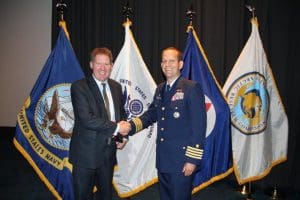
Michael Kingston
IUMI is lauded for helping frame safer practice for ships at the ‘ice edge’, By James Brewer
Insurance industry leaders have won praise for their work in helping finalise a Polar Code for merchant shipping and in drawing up what will be a supporting ‘ice regime’ to ensure vessels are thoroughly prepared for emergencies in harsh conditions.
The tribute came from Michael Kingston, the London lawyer who represents the International Union of Marine Insurance (IUMI) on a correspondence group, reporting to the International Maritime Organization, and which is developing guidance over how and when ships should proceed under specific ice-prone conditions.
Mr Kingston, a partner with law firm DWF, was speaking in Berlin in September 2015, at the annual conference of IUMI.
The international hull market is providing cover for selected voyages along the Northern Sea Route, but has been calling for ways of ensuring ship operators apply best practice and have viable crisis response plans.

Helle Hammer.
“It was clear that in order to make relevance of the Polar Code and reduce risk on an Arctic-wide basis… we had to do more work to link everything together: ice regime, the Polar Code and Ice Class, ” said Mr Kingston.
He referred to the huge amount of ongoing work on guidelines meant to strengthen the planned Polar Code, which is due to come into force in January 2017. The Code is the result of 22 years of high-level international lobbying and intense discussions.
A single ice regime was necessary “because the rules needed to be understood, not just to see what is required more clearly for ice patterns in the geographical area of operation, but to stop a third party bringing the house down for everyone. One mistake and that is the end of the huge investments, ” insisted Mr Kingston.
He went on: “The insurance market has worked together with international regulators, governments, operators and the research community to make a significant difference, and I commend the fantastic leadership of IMUI, and in particular the political forum.” The IUMI political forum, chaired by Norwegian marine insurance association managing director Helle Hammer, campaigns for the interests of the insurance market as a whole, in conjunction with IUMI alternate liaison officer at IMO, Nick Gooding, and IUMI secretary general Lars Lange.
Development of new methodology, which will be in addition to the Canadian AIRS system, Russian practice and the Swedish-Finnish rules in the Baltic Sea, is receiving great assistance from a cross-section of industry, and organisations in the Polar regions, said Mr Kingston. He mentioned in particular the cruise sector, including the Cruise Line International Association, the International Association of Antarctic Tour Operators and the Association of Arctic Expedition Cruise Operators.

Lars Lange
Under the Polar Code, operators must have a Polar Waters Operation Manual with a plan to deal with a worst-case scenario. They must have an ice regime methodology that shows how their ship will deal with ice in the area relevant to them, and the methodology must be explained in their Polar Ship Certificate issued by their flag state. “This methodology system has only just been developed and I have been working on it at the IMO with other industry representatives and world delegations, including all Arctic and Antarctic states. I am representing IUMI in that process, and it has been an honour to do so, with Lars Lange, Helle Hammer and Nick Gooding, ” said Mr Kingston.
He added: “I commend the IMO secretariat and all the world delegations and their leaders for all their great work, but they require the help of industry, as do national governments. They cannot get it right without our help – and we must engage with them – in a concerted way, so that, as well as saving lives at sea, by encouraging best practice, we will be acting in our best interests in the world’s insurance and maritime and energy industries also.”

Mr Kingston receives an award from Capt Mauger of the US Coast Guard for promoting maritime safety. Photo: US Coast Guard
He explained that the Polar Code is coming into force by way of an amendment to three existing conventions: environmental aspects under the International Convention for the Prevention of Pollution from Ships (Marpol); crew certification aspects under the International Convention on Standards of Training, Certification and Watch keeping for Seafarers 1978, known as STCW; and safety aspects under the Safety of Life at Sea Convention, Solas 1974.
(Mr Kingston said that the reason why the Polar Code is not a stand-alone convention, as originally intended, is that it was thought that it would, like so many other conventions, take too long to ratify.)
The insurance industry became particularly focused on navigation in the Polar regions following the Deepwater Horizon explosion in April 2010, after which BP incurred record criminal fines and huge economic loss through reputational damage. The Deepwater Horizon disaster killed 11 people and spilled 4.9m barrels of oil into the Gulf of Mexico.
Under conditions of high oil prices, there had been a tenfold increase in vessel transits of the Northern Sea Route between 2010 and 2012: a total of 46 vessels sailed in 2012, compared to 34 in 2011 and only four in 2010. In 2013 the figure increased to 71.
In September 2013 the Nordic Orion became the first bulk cargo vessel to go through the North West Passage and was followed in September 2014 by Fednav’s Nunavik as the first such vessel to do so without icebreaker assistance.

Nick Gooding
In 2014 in Scandinavia Statoil started production at 72.3 degrees N in the Barents Sea, Shell is active in Alaska and there is activity in the Russian Arctic. These moves north represented a paradigm shift in risk analysis, and information about the ‘ice edge’ was critical.
“What is clear, as we embark on this new phase in the Arctic in the shadow of the Gulf of Mexico oil spill, is that there was a fundamental requirement for voluntary co-operation in standards in order to protect everyone’s best interests.”
Approvingly, Mr Kingston compared progress towards the Polar Code with the convention on pollution from fixed structures “which has been lying on government shelves gathering dust since 1977, ” as had the Torremolinos convention for fishing boat safety which has been ratified by only three countries, “and it is for that reason that we must work together to get it right. In a way the Polar Code is an extraordinary achievement by the IMO and the world delegations when put in this context, and this [IUMI] conference should be proud of IUMI’s input.”
He warned: “There are major differences between regulatory regimes, standards and governance capacity across the Arctic states.”
The insurance industry would like to see companies operating in the Arctic implement robust risk management frameworks and processes that adopt best practice and contain worst-case scenarios, crisis response plans and full-scale exercises. Mr Kingston listed the main concerns: extreme cold which can cause engine problems and make it difficult or impossible for equipment to work; reduced coverage by navigational aids such as GPS; inaccurate charts, and magnetic compasses that are unreliable in high latitudes; restricted visibility up to 90% of the time; inadequate weather reports when violent storms can occur at any time; and “salvage facilities are almost non-existent.”
Although a search and rescue agreement had been signed by the Arctic states, “not a huge amount of progress has been made, ” although Russia had been placing more equipment along the Northern Sea Route.
The insurance industry had been uncomfortable with insuring Arctic risk and was very nervous following the Gulf of Mexico oil spill. There was a knowledge gap which made it difficult for insurers to agree to operations above 70 degrees N.
Any incident involving a cruise ship without ice class and with many people on board had the potential for catastrophic consequences. “This is a nightmare for insurers; such incidents do not inspire confidence within the insurance industry, and show that clear regulation is required.”
In September 2013 the Nordvik punctured its hull while transiting the Northern Sea Route. The tanker was unprepared for the ice conditions, and there could have been an enormous environmental catastrophe. An ice-breaker rescue of the research ship Akademik Shokalskiy in the Antarctic in January 2014 landed Australia with a bill for $1.6m.
The system developed by the international technical group is called POLARIS, an acronym for Polar Operational Limit Assessment Risk Indexing System. The aim of POLARIS is to provide a standard approach for the evaluation of risks from expected ice conditions by providing a risk index of a geographical area where a ship intended to travel. The system is similar to the Canadian Ice regime. Tables, definitions, and other technicalities are in the process of being agreed.
POLARIS uses a Risk Index Outcome (RIO) value to assess limitations for operation. For each geographical area, Risk Index Values (RV) assigned to the ship, based on its ice class, are used to determine a RIO that forms the basis of the decision to operate or to limit operation. If the RIO is zero or positive the ship may proceed without speed limitation.
If the RIO is between -1 and -10 the ship should proceed at a speed calculated by POLARIS, and if the RIO is below -10 the ship needs to demonstrate special circumstances.
Mr Kingston said: “My message is a simple one, but hard work is required to achieve it: we must work together in order to achieve best practice which will help to implement the Polar Code effectively and create the correct behavioural atmosphere for all Arctic operations.”
He made a further appeal: “In addition to education about the Polar Code, there is a lot of other work to do. Other areas require regulation: non-Solas vessels in Polar regions such as fishing vessels… and pollution from fixed structures.”
A partner in the marine, trade and energy group at DWF, Mr Kingston has for several years worked closely with the insurance industry, including P&I clubs, in relation to international regulation in the marine and offshore industry. Among other assignments, he worked with Lloyd’s on its 2012 Arctic report, and more recently on Lloyd’s Wreck Removal report.
Mr Kingston in July 2015 was presented with the US Coastguard Challenge Coin Medal by Capt John Mauger, Commanding Officer, US Coastguard Maritime Safety Centre, for his efforts to promote maritime safety by raising awareness about the Polar Code.





